Powering the Slum II: Alternative Sources of Energy in Accra’s Informal Settlements

Accessing clean and efficient energy is a critical challenge for informal settlement dwellers. While renewable energy holds promise, implementation is incipient. This policy digest explores efforts to introduce renewable energy to informal settlements in Accra, Ghana. How are residents responding and what challenges confront them?
At a Glance
Key Challenge
Solar and biogas technologies are fit for adoption in informal settlements but have limited adoption due to many barriers, including cost, knowledge, technical expertise, financial support, and others.
Policy Insight
In the Global South, most equipment for alternative energy sources is imported, which attracts tariffs and import duties. It is imperative to reduce or eliminate the tariffs and import duties on renewable energy equipment to stimulate investment and motivate people to acquire them.
Introduction
Major cities in the Global South are struggling to provide their residents with energy as they seek to implement Sustainable Development Goal (SDG) 7: “Ensure access to affordable, reliable, sustainable, and modern energy for all” (United Nations 2023). They have a particularly hard challenge in providing electricity legally in informal settlements that now house a billion people and are projected to triple by 2050 (Mahabir et al. 2016, McCauley et al. 2019). Further, with the International Energy Agency (IEA) projecting an increase of 30 percent in global energy demand by 2040 and fossil fuels becoming less attractive for their high Greenhouse Gas (GHG) emissions, they realize that renewable energy may well be part of the solution.
Renewables not only have the potential to supply the required energy but also can help implement other SDGs and the Paris Agreement, contribute to a green post-COVID-19 recovery, and offset the oil shortages due to the Russia-Ukraine war (Westphal et al. 2017). In fact, the African Development Bank (AfD) argues that renewable energy is “quick-win, wide-impact work” and “a strategic area of intervention” that underpins other critical leapfrog technologies that advance sustainable development (Bajpai et al. 2022). Despite its promise, instituting renewable energy in informal settlements is at an incipient stage.
This policy digest explores efforts to introduce renewable energy in the informal settlements in the Accra Metropolitan Assembly (AMA) in Ghana. It builds on previous studies, Powering the Slum: Meeting SDG 7 in Accra’s Informal Settlements and “Electricity and Informal Settlements: Towards Achieving SDG 7 in Developing Countries” (Mensah and Birch 2021, Mensah 2022). It provides examples of different applications. It outlines the challenges associated with them. Finally, it concludes with recommendations for advancing alternative energy in informal settlements.
Setting the Context for the Accra Case
Ghana’s electrical system is not only highly reliant on fossil fuels (66 percent of the total) but also does not meet demand due to rapid population growth, especially in the country’s urban informal settlements. See Figure 1. Further, its obsolete overrun transmission system is so unreliable that the providers frequently engage in power rationing/load shedding.
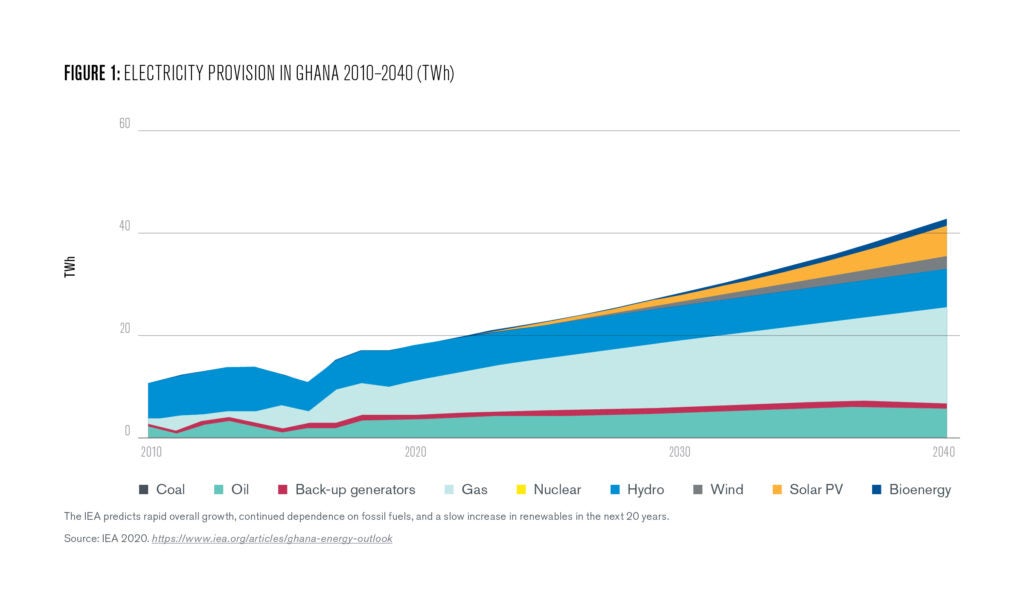
Ghanaians have given this practice a name, Dumsor, a colloquial word meaning “irregular blackout.” Dumsors have occurred for decades; particularly severe ones were in 1983–1984, 1997–1998, 2003, 2006–2007, and 2011–2016 (Kumi 2017). They continue to the present with an additional wrinkle: today, electric companies announce them in the newspapers and other public outlets. A typical headline reads: “Gridco Announces ‘Dumsor’ Schedule for Next 84 Days in Accra” (Gridco Announces “Dumsor” Schedule 2022).
Approximately one in three urban residents in the Global South dwells in informal settlements, places without access to such basic services like healthcare, potable water, durable housing, and modern reliable energy (UNESCO 2020, Singh et al. 2015). In the Accra Metropolitan Assembly (AMA), the subject of this study, the number is higher—60 percent of the population lives in informal settlements (People’s Dialogue 2016; UN-Habitat 2011).
The widespread lack of affordable and reliable energy severely limits informal settlers’ capacity to leap out of poverty and live safe, healthy, and productive lives. Official statistics provide baseline information but, as field studies reveal, they tell only part of the story. A summary is below:
- Globally, some 733 million people live without access to electricity, and close to 2.4 million people rely on inefficient and polluting cooking fuels (IEA 2022).
- Sub-Saharan Africa is the region with the largest energy access deficit—570 million people do not have access to electricity (IEA 2021).
- More than one hundred million urbanites in Sub-Saharan Africa live “under the grid”—literally living directly under transmission lines but lacking access to electricity (Ordarno 2019)
- Ghana (population of 31 million) is among the 20 highest access-deficit countries—places that together constitute 82 percent of the total population without electricity (IEA 2022, 64).
- Ghana’s Ministry of Energy records the nation’s electricity access as 87 percent—with 91 percent and 50 percent of urban and rural residents connected to the electricity grid, respectively (Ghana Statistical Service 2021, 38).
- The Ministry also cites regional variations. Some 94 percent of households in the Greater Accra Region have access to electricity while in the Upper East Region, the figure is 48 percent (Ghana Statistical Service 2018)
- Moreover, electricity access across localities and income quintiles varies as follows: 97 percent (highest urban quintile), 46 percent (lowest urban quintile), 86 percent (highest rural quintile), and 12 percent (lowest rural quintile) (Ghana Statistical Service 2019).
- Informal settlements in Ghana have high (88 percent) access to electricity (Ghana Statistical Service 2018).
While this high access statistic may hold in the three AMA informal settlements—Agbogbloshie, Chokor, and Avenor—reviewed for this study, it does not reflect the type of access. Seventy-five percent of the residents report having illegal connections i.e., sharing a meter with a legally connected household (Mensah and Birch 2021). Of note, while these households pay up to 500 percent more for their illegal connections and 60 percent more for tariffs to the meter holder than they would if they had legal connections, their payments to the meter holder are part of the local informal economy (Mensah and Birch 2021).
Illegal connections have several other consequences, including fire outbreaks and electrocutions as well as large financial losses for the provider (People’s Dialogue 2016; Briggs 2021; MIDA 2012, 2015). In AMA, the drivers of illegal electricity connections include the provider’s (e.g., Electricity Company of Ghana, ECG) poor operational performance and high tariffs.
Moreover, ECG’s rigid hook-up requirements—proof of ownership through presenting the land title, site plan, and building permit—are a major factor (Chaplin et al. 2019; Mensah and Birch 2021). Finally, informal settlers are typically trapped in what is popularly termed “energy poverty,” measured by households paying more than ten percent of their total income for electricity (Sovacool 2012; Butera et al. 2019). For example, studies have shown the severity of this phenomenon in Kenya (20–40 percent) (de Bercegol and Monstadt 2018), Brazil (15–25 percent), and Thailand (16–29 percent) (Grubler et al. 2012).
Informal settlers’ heavy reliance on such relatively cheap sources as charcoal, wood, or dung for cooking, and kerosene, improvised battery torches, candles, mobile phone illumination, or illegal hook-ups for lighting, presents a major challenge to changing this situation (Butera et al. 2015; Shupler et al. 2020; Thomas, Williamson, and Harper 2021). While solving Ghana’s electricity challenges calls for multiple investments such as expanding the metering system to include all public and private institutions, restructuring the tariff regime to ensure utilities can recover the cost of generation, and promoting energy efficiency programs, diversifying the energy generation mix is imperative (Kumi 2017).
Renewable sources like rooftop solar or biogas offer energy to informal settlers whom the utilities bar from household connections (due to their lack of titles to property as required by the companies or the absence of energy-supporting infrastructure within the crowded, informal settlements)1
Thus the question to be answered is this: How can the energy generation mix be diversified to yield the most affordable, reliable, and sustainable energy in informal settlements?
Before responding to this question for the case study sites, a brief explanation of local governance is useful. The AMA, located in the Greater Accra Region (GAR, 5.5 million population), one of Ghana’s 16 regions, is part of the 29 subregions that constitute an urban agglomeration, the Greater Accra Metropolitan Area (GAMA) within the GAR. GAMA in turn, encompasses a smaller unit, the Greater Accra Metropolitan Assembly (AMA). The AMA serves as the country’s capital and financial hub. It attracts an estimated 2 million people daily for commercial, administrative, educational, and recreational purposes but has a nighttime population of 608,000. See Figure 2.
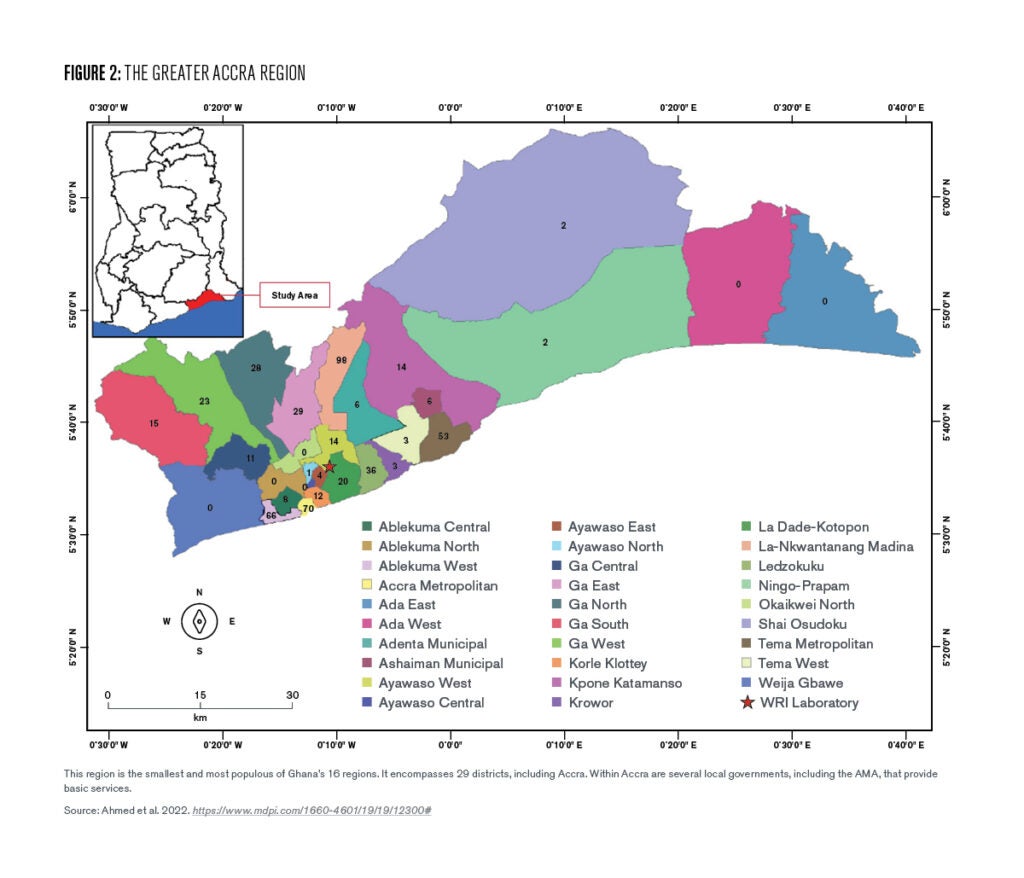
The AMA, in its various geographic forms, has captured a large portion of the rapid demographic growth experienced by the GAMA since the 1970s.2 One result has been the national government’s continuation of its decentralization policies outlined in the country’s 1992 constitution and succeeding legislation. Such policies have led to moving sub-areas out of the AMA jurisdiction and into independently governed districts.
The most recent subdivision in 2018 reduced the number of AMA sub-areas from ten to three, outlined in black in Figure 3 below. In this reorganization, the AMA’s population declined by 50 percent and its land area by 60 percent.

Regardless of the administrative changes, ongoing pressure on the infrastructure, especially housing, water, sanitation, and energy, has increased over time in the AMA. While the national government is charged with overall energy policy, the AMA is to supply the basic services–e.g., rights of way for access streets, official maps—necessary to accommodate the delivery of electricity.
Alternative Energy Use in Agbogloshie, Chorkor, and Avenor
Representative of each of AMA’s three sub-areas, the case study sites vary by age, size, and demography. The oldest is Chorkor (dating from the 1820s), followed by Agbobgloshie (1960s) and Avenor (1970s).
Agbogloshie, with its highly visible and hazardous e-waste recycling industries, is densely settled, with 80,000 people occupying nearly 80 acres (Afenah 2012; Oteng-Ababio 2018; Grant and Oteng-Ababio 2016; Grant and Oteng-Ababio 2019). The much larger Chorkor encompasses a 300-acre coastal site, has a population of 25,000, mainly indigenous people, whose main economic activity is fishing and fish-smoking.
The nearly 12,000 people who live in Avenor have land tenure based on customary (tribal) law. They are engaged in such informal activities as petty trading, tailoring, shoe repairs, hairdressing, food and water vending, and construction. See Figure 4.

While informal settlement dwellers in this study have access to electricity, they limit its use to a few items like powering television or freezing food. They use other sources—coconut husks, charcoal, and firewood for cooking and lighting.3 See Figure 5.
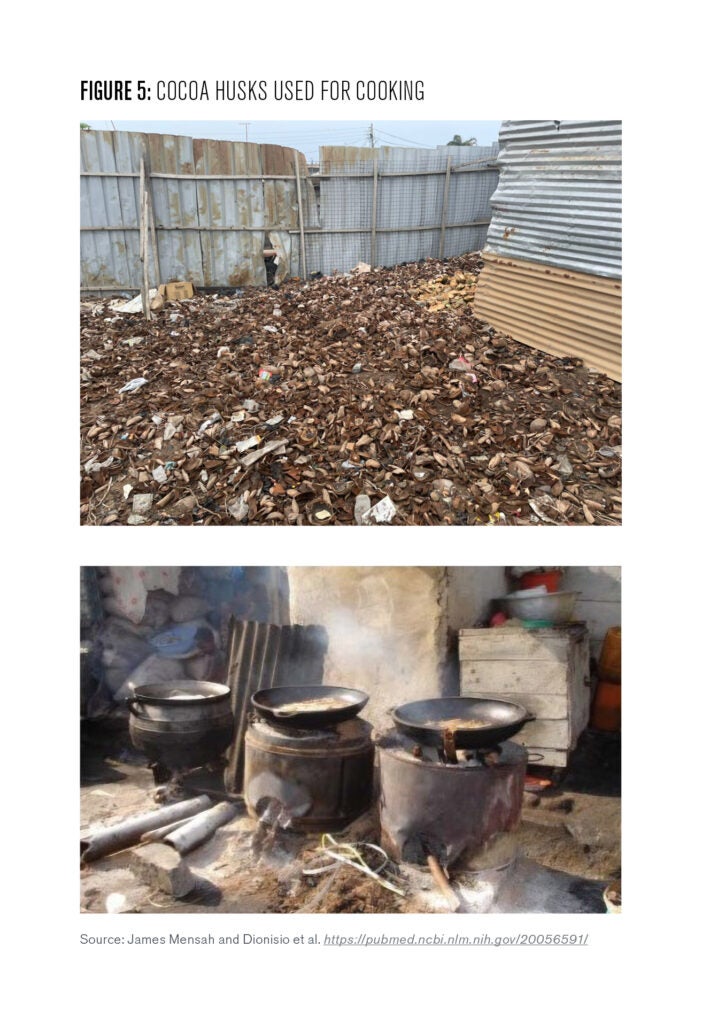
Recently, the residents have started to adopt solar and biogas to supply electricity. In the solar arena, they have widely engaged in small-scale projects employing solar power for flashlights or other low-energy drawing appliances. See Figure 6.
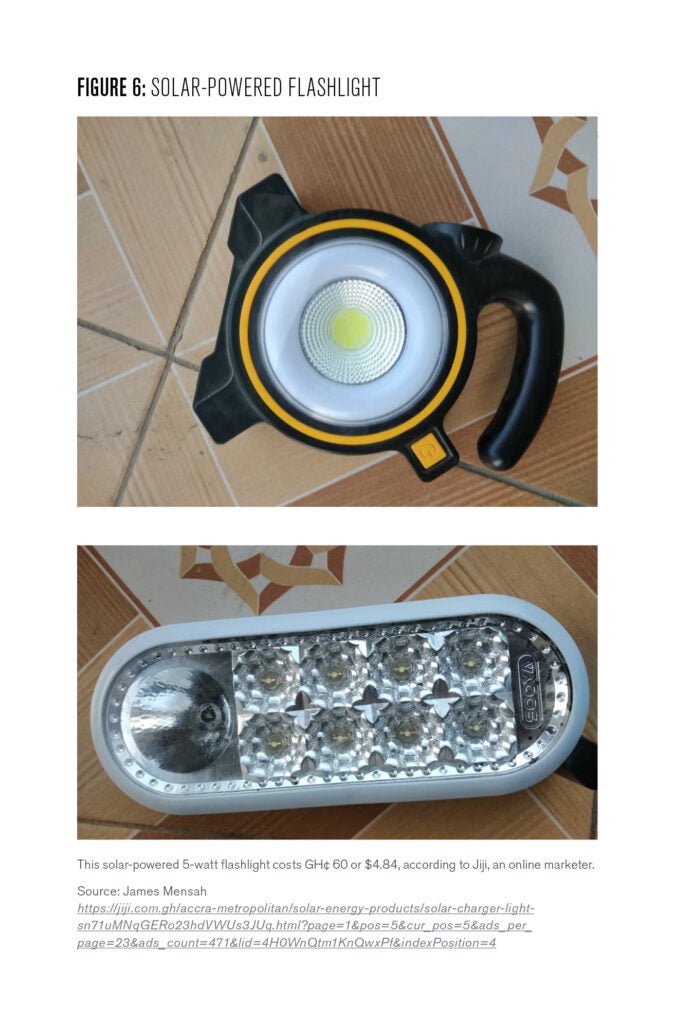
While the potential exists for the construction of larger scale solar projects, in the informal settlements selected for this study, the researchers found only one example: a health facility built with foreign aid under the country’s Community Health Planning Services (CHPS) program.4
In April 2022, officials from the program’s sponsors, the United Nations Development Program (UNDP), Japan’s Ministry of Health, and the Ghana Health Service opened the $60 million solar-powered Chorkor Chemuena Community Health Clinic. They had turned to solar as an economic solution for the site’s difficult location, one that prevented the installation of a traditional wiring system due to the lack of sufficient right of ways (streets). Since its installation in 2022, there has not been any maintenance carried out on the solar system. This is beginning to affect the performance of the solar system and the functioning of the clinic.
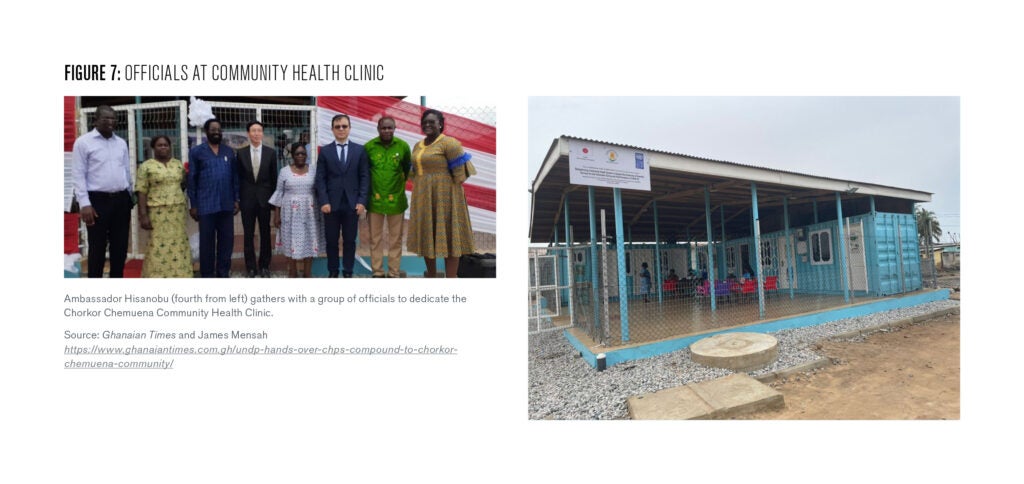
While several kinds of solar interventions exist for application in informal settlements, they have yet to be attempted in the case study sites. These include installing micro-grids and solar home systems (SHS), (Khandker et al. 2014; Keller 2012; World Bank 2017).
Two case study sites have examples of biogas use. Biogas, “an inflammable gas produced by bacteria in the process of fermentation of organic matter… under anaerobic conditions,” can be produced in such large-scale operations factories as seen in Germany and elsewhere or in small-scale, home-, or community-based arrangements (Nyang 2020, 25).
A home-based biogas system is relatively simple but requires up-front investment, skilled construction, operation, and maintenance. Figure 8 outlines the components: a latrine, digester, displacement chamber, mixing chamber, slurry pit, and piping. Installation requires skilled masons to construct the elements according to strict standards, while maintenance calls for easily-trained technicians.
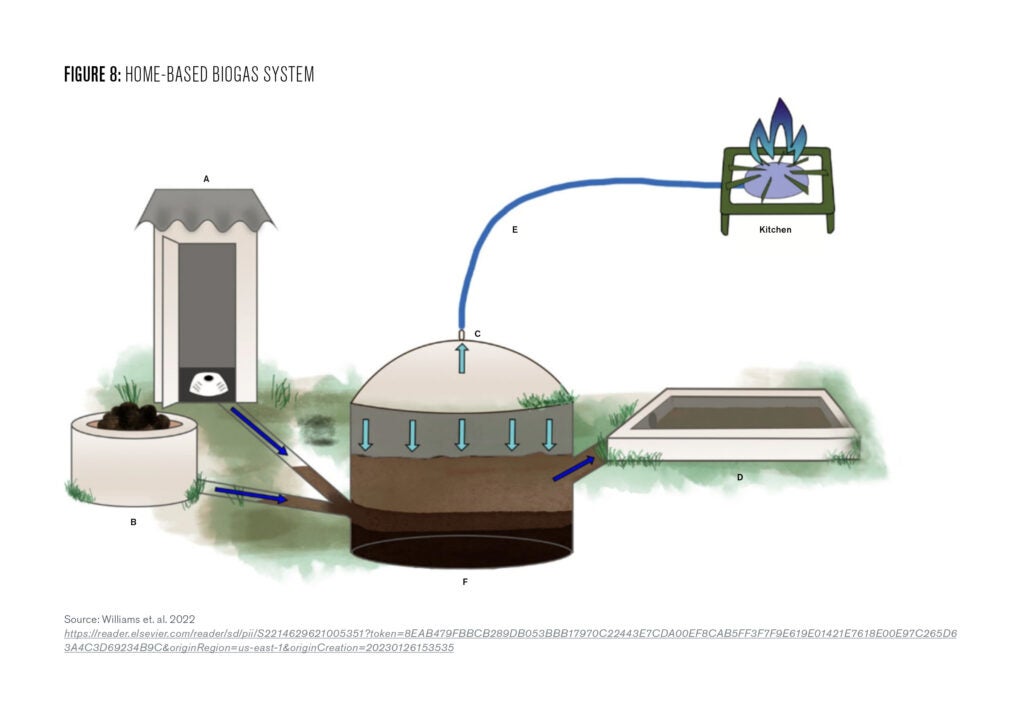
Biogas systems have a long history but are not widely adopted. In East Africa, for example, non-governmental organizations (NGOs) and local governments have been leaders in employing biogas latrines in informal settlements in Kampala (Uganda) and Nairobi (Kenya). Figure 9 shows the latrine installation within a public building in Nairobi or by a school in Kampala and the ultimate connections with cookstoves in both places.

Over time, various researchers have highlighted certain technological challenges related to design, specifics of operation and maintenance, cost, and amount of power produced (Mutai et al. 2016). Others have studied community acceptance, attributing its slow take-up to a lack of knowledge or awareness of the cleanliness (or naturalness) of the systems and deep-seated fears of contamination (Dumont et al. 2021).
Some biogas applications exist in Chorkor and Avenor. The Chorkor example is an owner-installed system in a compound house occupied by 60 people who use the system for cooking and heating. Resident interviews reflect high satisfaction, especially for its economic efficiency, as they have no electricity bills. The biogas system in the compound house is currently not well maintained; it is estimated that GHC 20,000 ($1,650) will be needed to properly maintain it. The future use of the biogas system in the house will depend on the ability to raise the money to maintain it. See Figure 10.
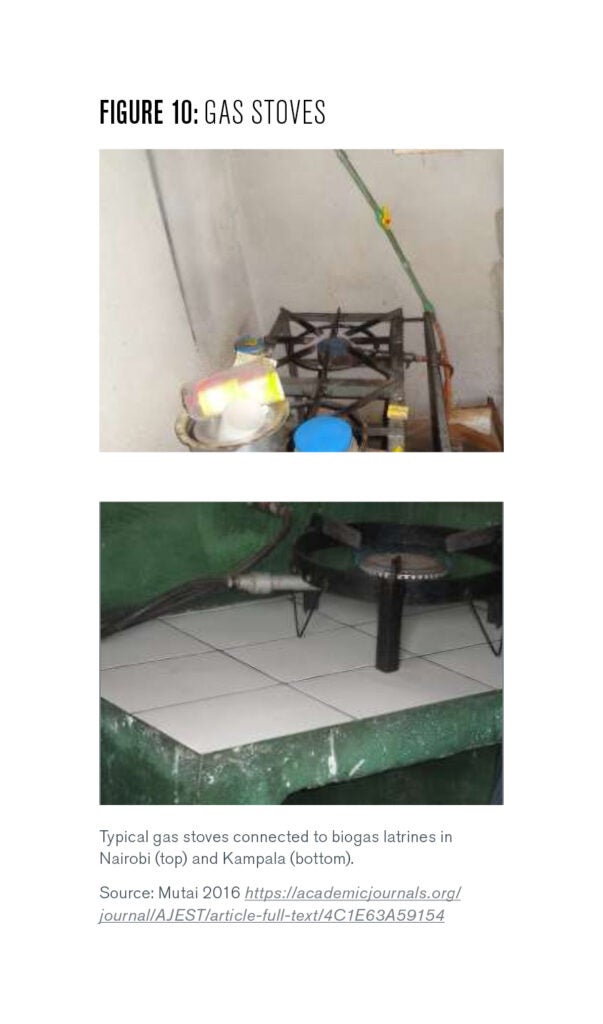
Whereas in Chorkor, the biogas application was for a single house, Avenor has a community system based in the area’s public toilet and bathhouse that services some 6,000 people. Funded by a public–private partnership involving the AMA and an individual investor, the business model revolves around user fees with separate payments for the toilet, bath, and biogas. A customer can use the toilet, bathe, and/or fill a cylinder with fuel.
The gas is also used to heat water for bathing in the bathrooms attached to the toilet. The system lacks pipelines due to the high cost and difficulty of installation. There is currently no maintenance challenge as the system was well built and still in the hands of the engineers. See Figure 11.
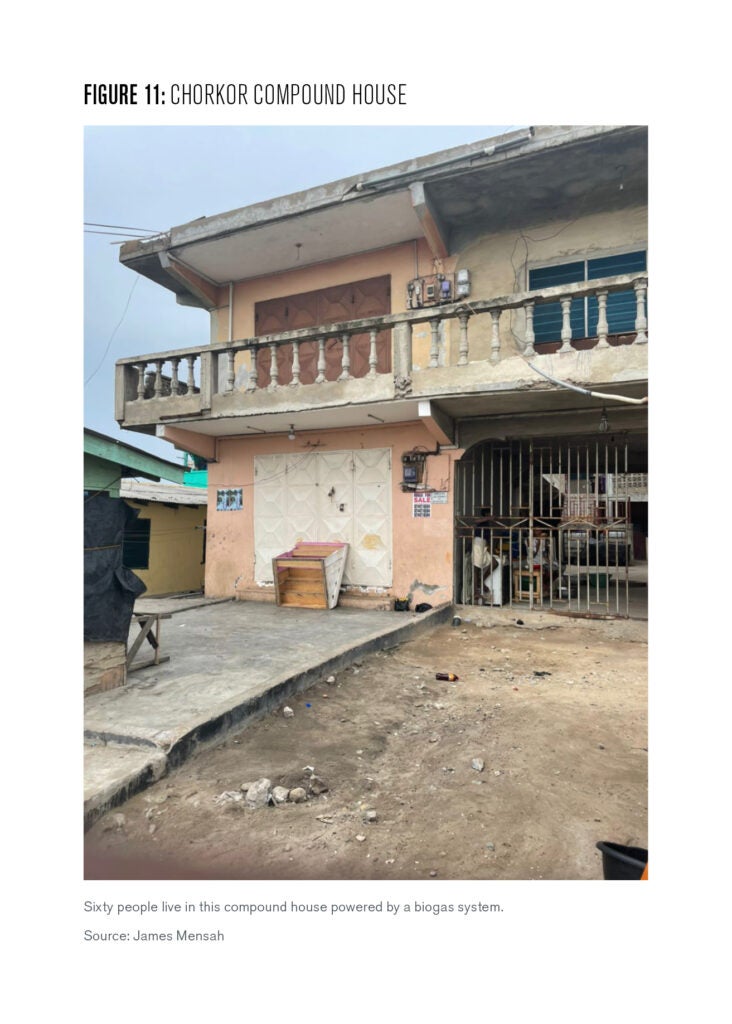
The research team for this paper discovered popular support for alternative energy solutions, including biogas and other systems. For example, Chorkor residents are currently appealing to the AMA to install a biogas system in its public toilets. At Avenor, Global Communities, an international NGO, worked with the area’s assembly member to explore solid waste-to-energy technologies and sponsored a trip to India to view applications. Upon his return, he assisted the community in trying to establish a system but failed due to the lack of space/land and funding for the necessary machinery, e.g., incinerator.
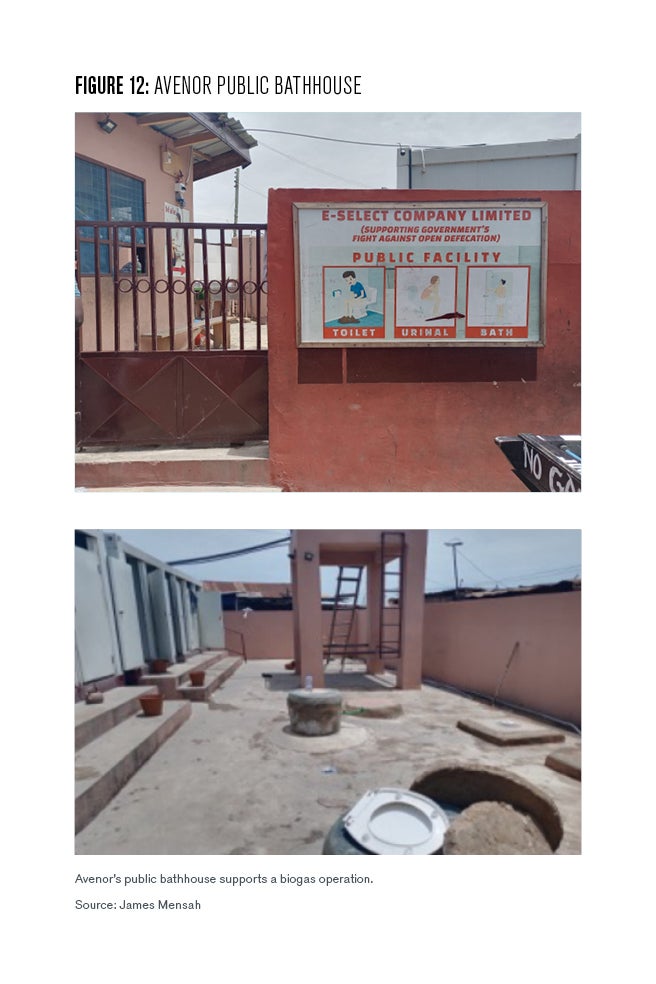
Conclusion
As places in the Global South seek to meet SDG 7 by increasing the use of renewable energy in informal settlements, they encounter multiple challenges:
- All levels of government lack the will or ability to provide all basic services, not just electricity.
- Fossil fuel-dependent providers are stressed to provide electricity legally, much less experiment with alternative energy.
- Informal settlers already rely on improvised systems—illegal shared metering, a situation contributing to the area’s informal economy—or inexpensive fuels such as charcoal or coconut husks for everyday use.
- Solar and biogas technologies are fit for adoption in informal settlements but have limited adoption due to many barriers, including cost, knowledge, technical expertise, financial support, and others.
A wider adoption of renewable energy in informal settlements requires changes, outlined in the recommendations below.
Recommendations
Transitioning to broader use of alternative energy in informal settlements involves a coordinated multi-stakeholder approach encompassing six basic steps to be undertaken systematically over time.
Extend Governmental Support
Whereas alternative energy sources have promise, all levels of government, acting within their constitutional functions, need to develop a sustained program to provide the necessary technical and financial support to informal settlements to transition to alternative energy sources such as solar, biogas, and waste-to-energy.
Develop Financing Arrangements
As part of an alternative energy program, energize financial support from NGOs, foreign assistance, the private sector through PPPs and locally. For example, at the local level, such savings groups as the Ghana Federation of Urban Poor (GHAFUP) that are active in slum upgrading initiatives have assets to deploy.5
Create Awareness for the Public and Community Members
Educate the public, especially informal settlement residents, on the benefits of renewable energy. Education will, in the medium to long term, help informal settlement dwellers start to integrate alternative sources of energy technologies into their energy mix. Policymakers, government officials, and NGOs should also understand the significance of alternative energy sources for informal settlement dwellers.
Remove Tariffs and Import Duties
In the Global South, most equipment for alternative energy sources is imported, which attracts tariffs and import duties. It is imperative to reduce or eliminate the tariffs and import duties on renewable energy equipment to stimulate investment and motivate people to acquire them.
Prioritize Alternative Energy in Informal Settlements.
Since extending the electricity grid to informal settlements is challenging due to the crowded nature of the place, government and energy providers should prioritize alternative sources of energy for these groups. This is important because the cost of these alternatives may be lower than traditional energy systems like dams. Similarly, traditional energy sources lead to the emission of greenhouse gases compared to alternatives like solar and biogas.
Offer Training
Training on alternative energy systems is an important strategy that will help scale up the use of alternative energy sources in informal settlements. It will not only help provide jobs for community members and local people, but also decrease the reliance on expensive foreign personnel. It is, therefore, imperative to train community members on the use, installation, repair, and maintenance of alternative energy systems.
Eugenie Birch
Lawrence C. Nussdorf Chair of Urban Research and EducationEugénie L. Birch is co-director of the Penn Institute for Urban Research, Lawrence C. Nussdorf Chair of Urban Research and Education, and chair of the Graduate Group in City and Regional Planning.
James Kwame Mensah
Lecturer, University of Ghana Business SchoolJames Kwame Mensah is a fellow at the Penn Institute for Urban Research and a lecturer in the Department of Public Administration and Health Services Management at the University of Ghana Business School.
Ahmed, H., M. Zolfo, A. Williams, J. Ashubwe-Jalemba, H. Tweya, W. Adeapena, A. Labi, Lady A. B. Adomako, G. N. D. Addico, R. A. Banu, and et al. 2022. “Antibiotic-Resistant Bacteria in Drinking Water from the Greater Accra Region, Ghana: A Cross-Sectional Study, December 2021–March 2022” International Journal of Environmental Research and Public Health 19, no. 19: 12300. https://doi.org/10.3390/ijerph191912300
Bajpai, A., S. Stratton-Short and I. Adelekan. 2022. Scaling Up Essential Services in African cities. African Development Bank. Cities Alliance/UNOPS. https://www.citiesalliance.org/resources/publications/cities-alliance-knowledge/paper-scaling-essential-services-african-cities
Berkouwer, S. B., P. E. Biscaye, S. L. Puller, and C. Wolfram. 2021. Disbursing Emergency Relief through Utilities: Evidence from Ghana, No. w28818. National Bureau of Economic Research.
Briggs, R. C. 2021. Power to Which People? Explaining How Electrification Targets Voters across Party Rotations in Ghana. World Development, 141, 105391.
Butera, F. M., R. S. Adhikari, P. Caputo and A. Facchini. 2015. “The Challenge of Energy in Informal Settlements: A Review of the Literature for Latin America and Africa.” Analysis of Energy Consumption and Energy Efficiency in Informal Settlements of Developing Countries, 1-32.
Butera, F. M., P. Caputo, R. S. Adhikari, and R. Mele. 2019. Energy Access in Informal Settlements: Results of a Wide On-Site Survey in Rio de Janeiro. Energy Policy, 134, 110943.
Chaplin, D., D. Welsh, A. Mamun, N. Ingwersen, K. Bos, E. Crossett. . .and W. Derbyshire. 2019. Ghana Power Compact: Evaluation Design Report (No. 8c1896c6f9af45f08347287c10e13432). Mathematica Policy Research.
de Bercegol, R. and J. Monstadt. 2018. “The Kenya Slum Electrification Program: Local Politics of Electricity Networks in Kibera.” Energy Research & Social Science, 41, 249-258.
Dionisio, K. 2010. “Within-Neighborhood Patterns and Sources of Particle Pollution: Mobile Monitoring and Geographic Information Systems in Four Communities in Accra, Ghana.” Environmental Health Perspectives, May. https://www.researchgate.net/publication/40894570_Within-Neighborhood_Patterns_and_Sources_of_Particle_Pollution_Mobile_Monitoring_and_Geographic_Information_System_Analysis_in_Four_Communities_in_Accra_Ghana
Dumont, K.B., D. Hildebrandt, and B.C. Sempuga. 2021. “The “‘Yuck” ’ Factor of Biogas Technology: Naturalness Concerns, Social Acceptance and Community Dynamics in South Africa.” Energy Research & Social Science. 71.
Grant, R., and J. Nijman. 2004. “The Re-Scaling of Uneven Development in Ghana and India.” Tijdschrift voor Economische en Sociale Geografie, 95(5), 467–481.
“Gridco Announces ‘Dumsor’ Schedule for Next 84 Days in Accra, Ghana Web. April 9, 2022. https://www.ghanaweb.com/GhanaHomePage/NewsArchive/GRIDCo-announces-Dumsor-schedule-for-the-next-84-days-in-Accra-1511675
Grubler, A., X. Bai, T. Buettner, S. Dhakal, D. J. Fisk, T. Ichinose . . . and H. Weisz. 2012. “Urban Energy Systems. In International Institute for Applied Systems Analysis (Ed.), Global Energy Assessment: Toward a Sustainable Future Cambridge, UK: Cambridge University Press and the International Institute for Applied Systems Analysis.
International Energy Agency. 2021. “Tracking SDG 7: The Energy Progress Report 2021.” Retrieved from https://trackingsdg7.esmap.org/data/files/download-documents/2021_tracking_sdg7_report.pdf
Keller, A. 2012. “Conceptualising a Sustainable Energy Solution for in situ Informal Settlement Upgrading.” Doctoral dissertation, Stellenbosch: Stellenbosch University.
Khandker, S. R., H. A. Samad, Z. K. M. Sadeque, M. Asaduzzaman, M. Yunus and A. K.E. Haque. 2014. Surge in Solar-powered Homes: Experience in Off-grid Rural Bangladesh. Washington DC: World Bank Publications.
Kumi, E. N. 2017. The Electricity Situation in Ghana: Challenges and Opportunities. Washington, DC: Center for Global Development.
Longe, O. M. 2021. “An Assessment of the Energy Poverty and Gender Nexus Towards Clean Energy Adoption in Rural South Africa.” Energies, 14(12), 3708.
Mahabir, R., A. Crooks, A. Croitoru, and P. Agouris. 2016. “The Study of Slums as Social and Physical Constructs: Challenges and Emerging Research Opportunities.” Regional Studies, Regional Science, 3(1), 399-419.
McCauley, D., V. Ramasar, R. J. Heffron, B. K. Sovacool, D. Mebratu and L. Mundaca. 2019. Energy Justice in the Transition to Low Carbon Energy Systems: Exploring Key Themes in Interdisciplinary Research.
Mensah, J.K. 2022. “Electricity and Informal Settlements: Towards Achieving SDG 7 in Developing Countries.” Energy Research and Social Science 93 https://www.sciencedirect.com/science/article/pii/S2214629622003474?casa_token=4vwo9LjGvsgAAAAA:v1U_KmEjGZFcXnxnvCO0T0gjQme37LkbO_zf_hGZa6xTRCJ0P-Ns3caACv_MRn7OpwZTy0BDfOI
Mensah, J. K. and E.L. Birch. 2021. Powering the Slum: Meeting SDG 7 in Accra’s Informal Settlements. Philadelphia: Kleinman Center of Energy Policy, University of Pennsylvania. https://kleinmanenergy.upenn.edu/wp-content/uploads/2021/04/KCEP-Powering-the-Slum.pdf
MIDA. 2012. Powering Ghana for Accelerated and Sustainable Economic Growth: Power Distribution and Utilisation Concept Paper. https://www.mida.gov.gh/pages/view/94/Introduction_and_Exec_Summary_Final_1_11_12.pdf
MIDA. 2015. Powering Ghana for Acceleration and Sustainable Economic Growth. Accra: MIDA.
Muringi, N. 2020. “Interview: Manufacturing Charcoal from Coconut Waste in Ghana,” How We Made it in Africa, October. https://www.howwemadeitinafrica.com/interview-manufacturing-charcoal-from-coconut-waste-in-ghana/73005/
Mutai, P., C. Niwagaba, J. B. Tumuhairewe, R. Kulabako, A. Katukiza, P. Nyene, and F. Kansiime. 2016. “Key Factors Affecting Performance of Biogas Latrines in Urban Informal Areas: The Case of Kampala and Nairobi, East Africa.” African Journal of Environmental Science and Technology 10. https://academicjournals.org/journal/AJEST/article-full-text/4C1E63A59154
Nyang, C., P. M. Nina, and A. U. Hussein. 2020. “Valuing Biogas Production From Socio-Economic and Environmental Dimensions.” African Journal of Economics and Sustainable Development 3(1) https://www.researchgate.net/profile/PiusNina/publication/339899952_VALUING_BIOGAS_PRODUCTION_FROM_SOCIOECONOMIC_AND_ENVIRONMENTAL_DIMENSIONS/links/5e6b455c92851c6ba7fda765/VALUING-BIOGAS-PRODUCTION-FROM-SOCIO-ECONOMIC-AND-ENVIRONMENTAL-DIMENSIONS.pdf
Oduro-Appiah, K., A. Afful, V. N. Kotey, and N. De Vries. 2019. “Strategy for Sustainable Modernization of Municipal Solid Waste Management Systems in Lower-Middle Income Cities: Lessons from Accra.” Resources 8, no. 1: 12. https://doi.org/10.3390/resources8010012
Ordano, L. 2019. “Closing Sub Saharan Africa’s Electricity Access Gap: Why Cities Must Be Part of the Solution.” August 14. https://www.wri.org/insights/closing-sub-saharan-africas-electricity-access-gap-why-cities-must-be-part-solution
Oteng-Ababioa, M. and R. Grant. 2018. “Ideological Traces in Ghana’s Urban Plans: How Do traces Get Worked Out in the Agbogbloshie, Accra?” Habitat International Vol 83, https://pdf.sciencedirectassets.com/271760/1-s2.0-S0197397519X00028/1-s2.0-
People’s Dialogue. 2016. Know Your City: City Wide Informal Settlements. Putting Accra Metropolitan Settlements on the Map, Accra Ghana: Cities Alliance.
Shupler, M., J. Mwitari, A. Gohole, R.A. de Cuevas, E. Puzzolo, I. Cukic, . . . and D. Pope. 2020. “COVID-19 Lockdown in a Kenyan Informal Settlement: Impacts on Household Energy and Food security.” MedRxiv. https://www.medrxiv.org/content/medrxiv/early/2020/05/29/2020.05.27.20115113.full.pdf
Sovacool, B. K. 2012. ”The Political Economy of Energy Poverty: A Review of Key Challenges.” Energy for Sustainable Development, 16(3), 272-282.
Thomas, P. J. M., S. J. Williamson, and P.W. Harper. 2021. “The Diffusion of Solar Home Systems in Rwandan Refugee Camps.” Energy for Sustainable Development, 63, 119-132.
United Nations. 2023. “The 17 Goals | Sustainable Development” https://sdgs.un.org/goals.
United Nations. 2015. “World Population Projected to Reach 9.7 Billion by 2050.” https://www.un.org/en/development/desa/news/population/2015-report.html
Wang, H. 2022. Unbalanced Investments: The Impact of Municipal Finance and Governance on Accra’s Informal Settlements Toronto: Institute on Municipal Finance and Governance (IMFG), University of Toronto. https://tspace.library.utoronto.ca/bitstream/1807/124854/1/imfgpersp_no33_accra_hsi-chuan_wang_november_4_2022.pdf
Westphal, M.I., S. Martin, L. Zhou, and D. Satterthwaite. 2017. Powering Cities in the Global South: How Energy Access for All Benefits the Economy and the Environment. Working Paper. Washington, DC: World Resources Institute. Available online at www.citiesforall.org
Williams, N.B., R.S. Quilliam, B. Campbell, R. Ghatani, and J. Dickie. 2022. “Taboos, Toilets, and Biogas: Socio-Technical Pathways to Acceptance of a Household Technology.” Energy & Social Science 22. April. https://www.sciencedirect.com/science/article/pii/S2214629621005351
World Bank Group. 2017. Enhancing Urban Resilience in the Greater Accra Metropolitan Area. May. https://documents1.worldbank.org/curated/en/949241495793834492/pdf/115296-REPLACEMENT-PUBLIC-Accra-v5-highres-nocutmarks.pdf.
World Bank Group. (2017). State of Electricity Access Report. https://www.worldbank.org/en/topic/energy/publication/sear#:~:text=The%20State%20of%20Electricity%20Access,the%20recent%20Global%20Tracking%20Framework
- For details, see Mensah, J. K. and E.L. Birch. 2021. Powering the Slum: Meeting SDG 7 in Accra’s Informal Settlements. Philadelphia: Kleinman Center of Energy Policy, University of Pennsylvania. https://kleinmanenergy.upenn.edu/wp-content/uploads/2021/04/KCEP-Powering-the-Slum.pdf [↩]
- In 1970, the GAMA population was 650,000; today it is 2,500,000. [↩]
- In 2014, an entrepreneurial university student invented Zaacoal, green charcoal produced from coconut husks. While a contributor to the circular economy purchased by recreational (high income) cooks for weekend barbecues, it has not become a major factor for informal settlers (Murungi 2020). [↩]
- The national government initiated CHPS to deliver community-based health care for disadvantaged groups in rural areas in 2005 and later expanded it to urban informal settlements. Accra has 22 sites. [↩]
- The Ghana Federation of Urban Poor (GHAFUP) has funded rooftop solar in Amor Dzor, Ashaiman, Greater Accra. https://sdinet.org/2018/08/amui-dzor-solar-project-ashaiman-ghana/ [↩]


